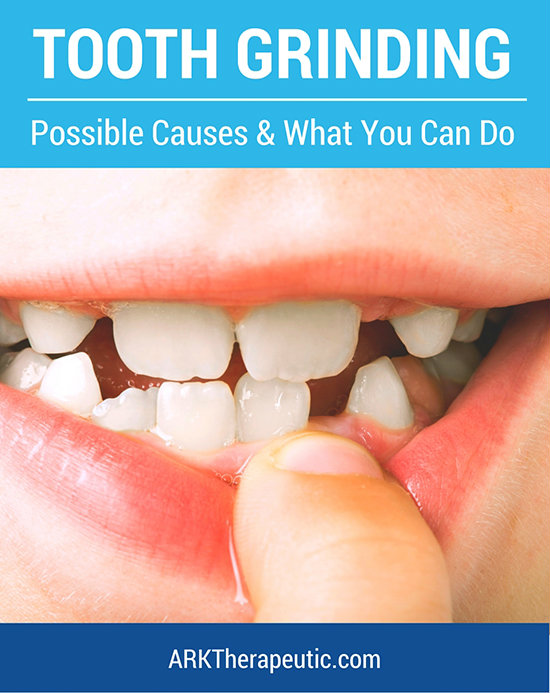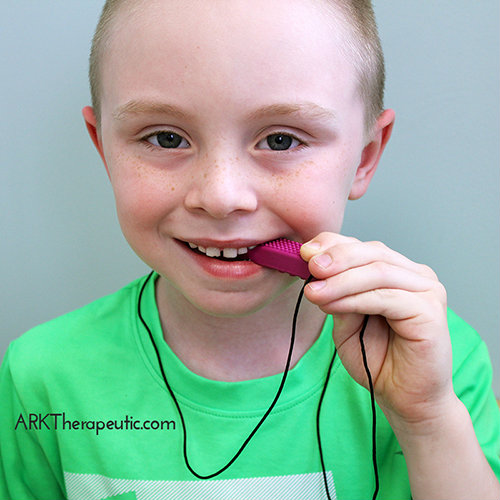Tooth Grinding - Possible Causes & What You Can Do
Posted by Debra C. Lowsky, MS, CCC-SLP on 22nd Jan 2013
While many kids outgrow grinding their teeth, intervention may be necessary if they don't. Tooth grinding over a prolonged period (especially with permanent teeth) may put them at risk for worn-down teeth, tooth sensitivity, jaw pain, headaches, etc. There is no one accepted reason as to why it happens, but there are several factors that may be contributing to the problem:
.

.
DENTAL PROBLEMS
First and foremost, I recommend that you see a dentist to rule out any underlying medical issues that may be the cause of tooth grinding, such as an abnormal bite, misaligned teeth, etc. A dentist may also recommend a bite guard, especially if the problem only persists at night.
.
MEDICATION SIDE EFFECT
Check the medications that your child is on. Is tooth grinding a side effect? If so, consult with his/her doctors to see if there is a suitable alternative.
.
STRESS / ANXIETY
Many people say that tooth grinding/clenching is stress-related. Try to pinpoint possible sources of stress and see if anything can be done to resolve them.
.
HABIT
Could they be grinding their teeth out of habit? If so, work on replacing the habit with a safer alternative. For example, every time your child grinds their teeth, provide them with an oral fidget to chew on instead. Be patient and consistent.
.

.
It's also worth noting that a recent study on bruxism (the technical term for clenching or grinding the teeth) found success with verbally telling a young girl to stop grinding her teeth. Sounds simple, but habits are often done unconsciously/automatically. So a verbal reminder may help make them more aware of what they're doing, and they can in turn curb it.
.
STIMMING
Tooth grinding may be a form of stimming. Short for self-stimulation, stimming is a way that individuals who have Autism and/or sensory processing disorder (SPD) calm and organize themselves, especially in times of stress or extreme emotions. If this is the case with your child, an occupational therapist can assess their needs and put in place what's called a "sensory diet" of activities that will allow them to safely self-regulate throughout the day. In the meantime, it's possible that an oral fidget / chew tool will help be a replacement behavior for teeth grinding.
.
ORAL HYPOSENSITIVITY
If your child is hyposensitive, he/she may be grinding their teeth because they needs more oral input. Hyposensitive individuals have little to no awareness in their mouths, which means that they have a high threshold for oral input. As a result, they may seek out orally stimulating activities that provide lots of proprioceptive feedback, such as mouth stuffing, excessive chewing on shirts, hands, pencils, etc., and/or tooth grinding. A speech therapist and/or occupational therapist trained in SPD will be able to assess your child and implement intervention strategies based on his needs. Many of these strategies involve providing oral input in more appropriate ways, such as the following:
• Gum massage - this is a great activity to begin with. It's an easy and effective way to provide input to all areas of the mouth.
• ARK's Probe, proPreefer, Z-Vibe, and Z-Grabber - these oral motor tools can be used to safely provide proprioceptive input within the oral cavity. Use them to tap, stroke, and apply gentle pressure to the lips, tongue, cheeks, and gums. Vary your pressure, the length of your strokes, and the duration of the stimulation. With guided assistance, allow the child to mouth and explore the tips. There are many different tips available for the Z-Vibe and Z-Grabber for varied sensory experiences. The Animal Tips are a great option to start with, as these fun critters have lots of shapes, textures, and pockets to explore.
• Vibration - The Z-Vibe and Z-Grabber can also be turned on to vibrate. Vibration provides a new level of sensory stimulation to increase oral focus and awareness. Many individuals also find it calming and soothing.
.

.
• Oral Sensory Chews - Such as the Grabber, Y-Chew, and/or chewelry, allow the child to mouth safe chewing tools and create a replacement behavior for teeth grinding. These sensory chewies have long extensions that reach all the way to the back molar area for proprioceptive feedback to the jaw. The textured options are particularly recommended for sensory seekers. You can also have the child bite down on the Grabber/Y-Chew and hold as you gently tug on it 3-5 times. Repeat on both sides of the jaw up to 5 times throughout the day. (This exercise provides additional input to the jaw.)
• Diet - Incorporate more hard-to-chew foods into his diet, such as apples, celery, and carrots.
• For more information on this topic click here.
.
GLOBAL HYPOSENSITIVITY
Tooth grinding could also be a symptom of global hyposensitivity, not just oral hyposensitivity. For instance, when children have low muscle tone or awareness throughout the body, they sometimes have difficulty turning on just one muscle group. They could engage their jaw muscles while they are trying to stabilize their trunk to sit upright, and therefore grind their teeth. If this is the case, a physical therapist and occupational therapist will be able to work on the ability to disassociate muscle groups. This can sometimes be common in children with cerebral palsy. . (A big thank you to Kate Schoen, OTR/L for this information on global hyposensitivity).
.
DIET
Children on a limited diet may still have the need to chew and bite and gnaw their food – and they may need to hear it happening. Without this important element of eating, they may grind their teeth in search of that tactile and auditory feedback.
• If the diet is limited because of oral motor and/or sensory aversions, check out this article for further reading.
• If the diet is limited because of picking eating, try these tips for pleasing picky eaters.
• If the child is g-tube fed or on a diet limited to soft/puréed foods for medical reasons, they may still have the urge to physically chew. Allow them to chew on an oral sensory chew tool, especially the textured ones, as these simulate the feel of real food.
.

